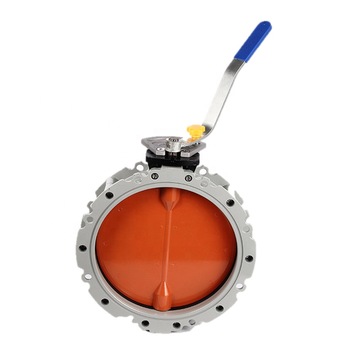1. Manual butterfly valve: simple and efficient
The manual butterfly valve is a valve that relies on manual rotation to control the valve plate to open and close. Its core advantages are:
Simple structure: very few mechanical parts mean low failure rate and easy maintenance.
Intuitive operation: the rapid opening and closing of the fluid can be achieved by rotating the lever, which is very suitable for fluid regulation of small and medium-sized pipelines.
This valve is widely used in water treatment, HVAC and light industry. Its intuitive use and low maintenance cost make it an ideal choice in many processes.
2. Manual double flange butterfly valve: a new breakthrough in process design
Based on the traditional manual butterfly valve, the manual double flange butterfly valve adopts a double flange design to achieve a higher level of sealing performance. This unique structural design brings the following advantages:
Enhanced sealing: The double flange structure effectively prevents medium leakage, especially under high pressure and high temperature conditions.
Solid structure: The added flange not only provides additional mechanical support, but also better adapts to complex pipeline interfaces.
This valve is usually used in occasions requiring strict process control, such as chemical and petroleum pipelines, to ensure the safety and stability of fluid transmission.
3. Flange butterfly valve: modular design and industrial application
Flange butterfly valve is widely used in large process systems due to its unique flange connection method. Its main features include:
Convenient installation and disassembly: Flange connection makes the valve require no special tools during installation and maintenance, and the operation is more efficient.
Strong adaptability: It can be perfectly connected with various pipeline interfaces and is suitable for large industrial pipelines, power plants and petrochemical industries.
High sealing performance: Compared with traditional butterfly valves, the flange structure provides a higher level of sealing effect and effectively prevents fluid leakage.
This design not only simplifies the installation and commissioning process, but also provides a strong guarantee for the long-term stable operation of industrial systems.
4. Design comparison and application selection
From the perspective of overall structure and performance, these three butterfly valves have their own advantages:
Manual butterfly valve: simple structure, suitable for systems with low requirements for fluid control, ensuring economy and reliability.
Manual double flange butterfly valve: Through the double flange design, it achieves excellent sealing effect, which is particularly suitable for use in high pressure or high temperature environments to ensure system safety.
Flange butterfly valve: Due to its modular flange connection design, installation and maintenance are more convenient, suitable for large pipe networks and occasions that require frequent maintenance.
In actual selection, engineers need to comprehensively consider the working conditions, medium characteristics, maintenance requirements and economic benefits, and choose the most suitable valve type to optimize system performance.
V. Future Outlook and Technology Trends
With the development of industrial automation and intelligent control technology, the boundary between traditional manual and automatic control is gradually blurring. In the future, butterfly valve technology will further develop in the direction of intelligence and modularization:
Intelligent butterfly valve: integrated sensors and remote monitoring systems to achieve real-time data monitoring and early warning functions.
High-performance sealing materials: The application of new materials will enable the valve to maintain high sealing performance and durability under extreme working conditions.
Quick installation and maintenance: Modular design and standardized interfaces provide more convenient options for large industrial projects.
Continuous technological innovation is driving these products towards higher sealing effects, more convenient operation methods and smarter management systems. If you are interested in smart butterfly valves or related automation solutions, future discussions and explorations will be broader and deeper.
Post time: Jun-10-2025




